Intel's Pentium M Desktop Part II: ASUS' Pentium M to Pentium 4 Socket Adapter
by Anand Lal Shimpi on March 24, 2005 1:31 PM EST- Posted in
- CPUs
Workstation Applications
Visual Studio 6
Carried over from our previous CPU reviews, we continue to use Visual Studio 6 for a quick compile test. We are still using the Quake 3 source code as our test and measure compile time in seconds.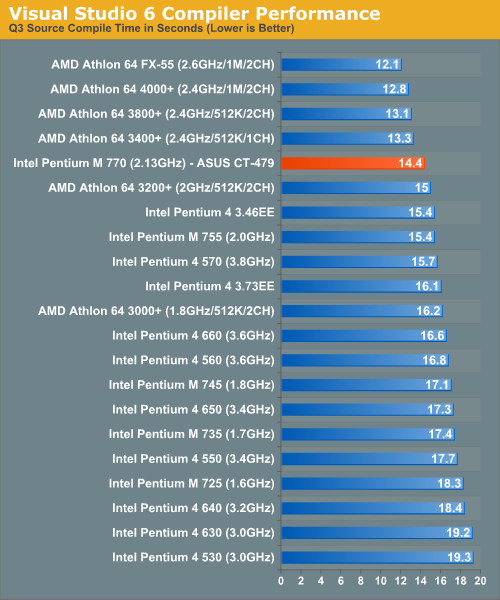
SPECviewperf 8
For our next set of professional application benchmarks, we turn to SPECviewperf 8. SPECviewperf is a collection of application traces taken from some of the most popular professional applications, and compiled together in a single set of benchmarks used to estimate performance in the various applications that the benchmark is used to model. With version 8, SPEC has significantly improved the quality of the benchmark, making it even more of a real world indicator of performance.We have included SPEC's official description of each one of the 8 tests in the suite.
The Pentium M doesn't excel in any of the SPECviewperf tests, but its performance is much more respectable with the ASUS solution, thanks to a more balanced memory bandwidth system.
3dsmax Viewset (3dsmax-03)
"The 3dsmax-03 viewset was created from traces of the graphics workload generated by 3ds max 3.1. To ensure a common comparison point, the OpenGL plug-in driver from Discreet was used during tracing.
The models for this viewset came from the SPECapc 3ds max 3.1 benchmark. Each model was measured with two different lighting models to reflect a range of potential 3ds max users. The high-complexity model uses five to seven positional lights as defined by the SPECapc benchmark and reflects how a high-end user would work with 3ds max. The medium-complexity lighting models use two positional lights, a more common lighting environment.
The viewset is based on a trace of the running application and includes all the state changes found during normal 3ds max operation. Immediate-mode OpenGL calls are used to transfer data to the graphics subsystem."
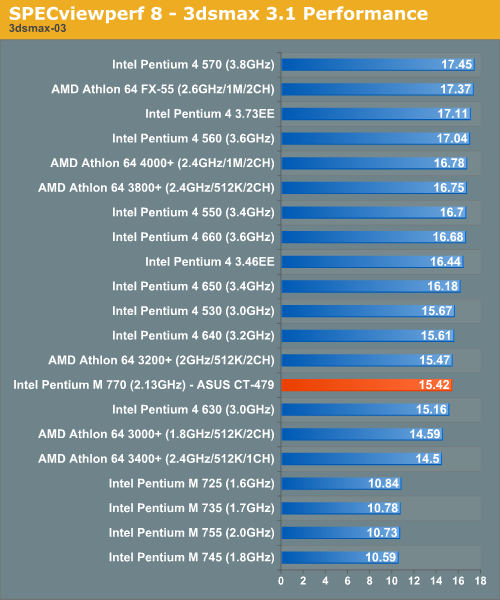
CATIA Viewset (catia-01)
"The catia-01 viewset was created from traces of the graphics workload generated by the CATIATM V5R12 application from Dassault Systems.
Three models are measured using various modes in CATIA. Phil Harris of LionHeart Solutions, developer of CATBench2003, supplied SPEC/GPC with the models used to measure the CATIA application. The models are courtesy of CATBench2003 and CATIA Community.
The car model contains more than two million points. SPECviewperf replicates the geometry represented by the smaller engine block and submarine models to increase complexity and decrease frame rates. After replication, these models contain 1.2 million vertices (engine block) and 1.8 million vertices (submarine).
State changes as made by the application are included throughout the rendering of the model, including matrix, material, light and line-stipple changes. All state changes are derived from a trace of the running application. The state changes put considerably more stress on graphics subsystems than the simple geometry dumps found in older SPECviewperf viewsets.
Mirroring the application, draw arrays are used for some tests and immediate mode used for others."
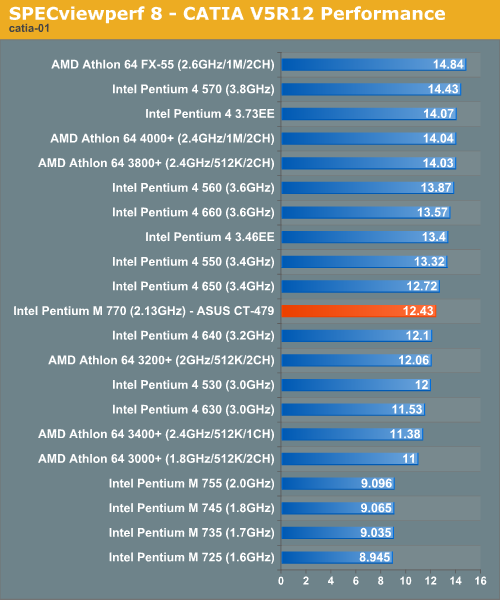
Lightscape Viewset (light-07)
"The light-07 viewset was created from traces of the graphics workload generated by the Lightscape Visualization System from Discreet Logic. Lightscape combines proprietary radiosity algorithms with a physically based lighting interface.
The most significant feature of Lightscape is its ability to simulate global illumination effects accurately by precalculating the diffuse energy distribution in an environment and storing the lighting distribution as part of the 3D model. The resulting lighting "mesh" can then be rapidly displayed."
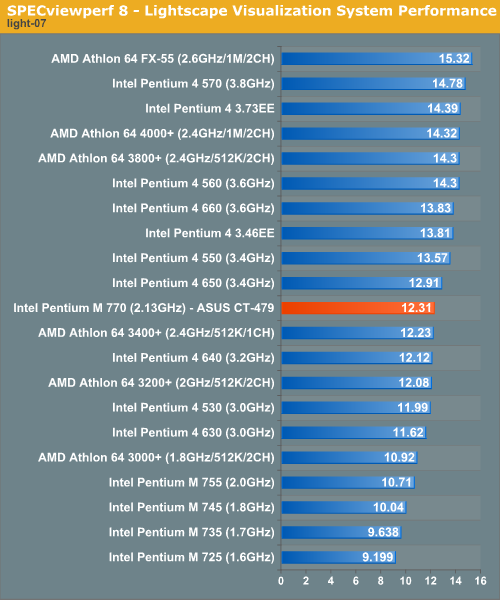
Maya Viewset (maya-01)
"The maya-01 viewset was created from traces of the graphics workload generated by the Maya V5 application from Alias.
The models used in the tests were contributed by artists at NVIDIA. Various modes in the Maya application are measured.
State changes as made by the application are included throughout the rendering of the model, including matrix, material, light and line-stipple changes. All state changes are derived from a trace of the running application. The state changes put considerably more stress on graphics subsystems than the simple geometry dumps found in older viewsets.
As in the Maya V5 application, array element is used to transfer data through the OpenGL API."
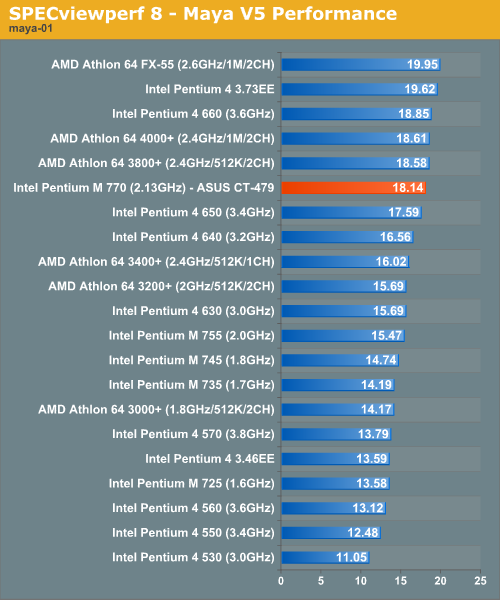
Pro/ENGINEER (proe-03)
"The proe-03 viewset was created from traces of the graphics workload generated by the Pro/ENGINEER 2001TM application from PTC.
Two models and three rendering modes are measured during the test. PTC contributed the models to SPEC for use in measurement of the Pro/ENGINEER application. The first of the models, the PTC World Car, represents a large-model workload composed of 3.9 to 5.9 million vertices. This model is measured in shaded, hidden-line removal, and wireframe modes. The wireframe workloads are measured both in normal and antialiased mode. The second model is a copier. It is a medium-sized model made up of 485,000 to 1.6 million vertices. Shaded and hidden-line-removal modes were measured for this model.
This viewset includes state changes as made by the application throughout the rendering of the model, including matrix, material, light and line-stipple changes. The PTC World Car shaded frames include more than 100MB of state and vertex information per frame. All state changes are derived from a trace of the running application. The state changes put considerably more stress on graphics subsystems than the simple geometry dumps found in older viewsets.
Mirroring the application, draw arrays are used for the shaded tests and immediate mode is used for the wireframe. The gradient background used by the Pro/E application is also included to better model the application workload."
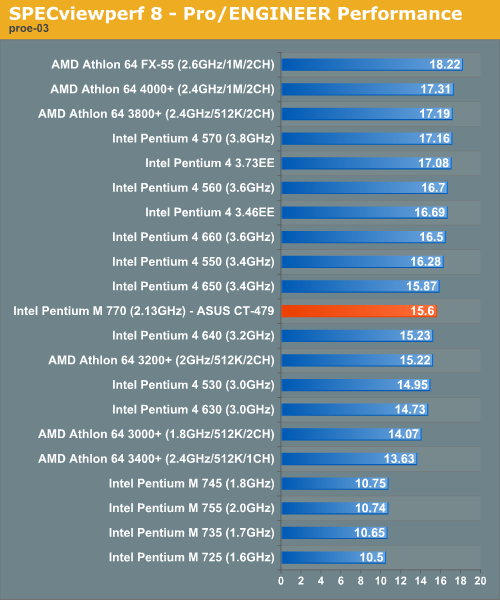
SolidWorks Viewset (sw-01)
"The sw-01 viewset was created from traces of the graphics workload generated by the Solidworks 2004 application from Dassault Systemes.
The model and workloads used were contributed by Solidworks as part of the SPECapc for SolidWorks 2004 benchmark.
State changes as made by the application are included throughout the rendering of the model, including matrix, material, light and line-stipple changes. All state changes are derived from a trace of the running application. The state changes put considerably more stress on graphics subsystems than the simple geometry dumps found in older viewsets.
Mirroring the application, draw arrays are used for some tests and immediate mode used for others."
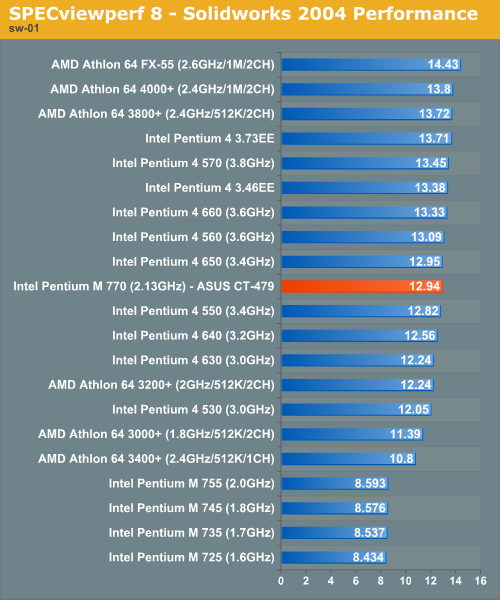
Unigraphics (ugs-04)
"The ugs-04 viewset was created from traces of the graphics workload generated by Unigraphics V17.
The engine model used was taken from the SPECapc for Unigraphics V17 application benchmark. Three rendering modes are measured: shaded, shaded with transparency, and wireframe. The wireframe workloads are measured both in normal and anti-alised mode. All tests are repeated twice, rotating once in the center of the screen, and then moving about the frame to measure clipping performance.
The viewset is based on a trace of the running application and includes all the state changes found during normal Unigraphics operation. As with the application, OpenGL display lists are used to transfer data to the graphics subsystem. Thousands of display lists of varying sizes go into generating each frame of the model.
To increase model size and complexity, SPECviewperf 8.0 replicates the model two times more than the previous ugs-03 test."
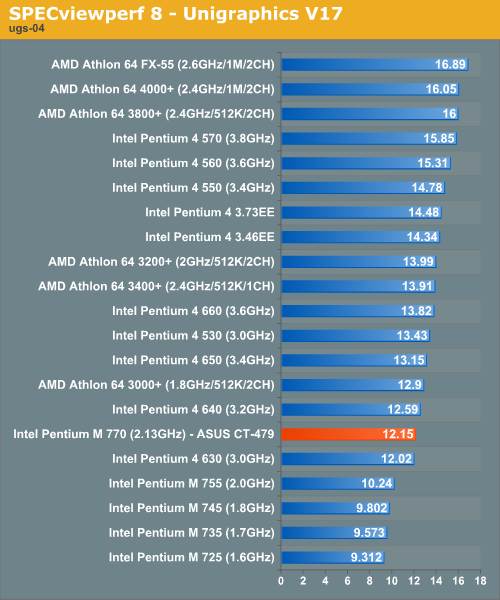










48 Comments
View All Comments
Spajky - Saturday, May 14, 2005 - link
Spajky - Saturday, May 7, 2005 - link
Some comments:http://www.anandtech.com/cpuchipsets/showdoc.aspx?...
>WinRAR 3.40
Pulling the hard disk out of the equation, we can get a much better idea of which processors are truly best suited for file compression<
>The WinRAR test is particularly memory bandwidth intensive, so the move to a platform that can feed the Pentium M adequately increases performance tremendously. However, even with the boost, the best that the Pentium M can do is match the performance of Intel desktop CPUs. It still can't touch the Athlon 64s<
Data compression, WinRAR 3.42, KB/s - Irrelevant CPU bench/graph !!!
It can be treated as a real life memory subsystem benchmark instead !
WinRAR´s built_in benchmark & hardware test" is NOT a Data Compression Bench :
some tests/benchmarks & explanation HOW IT WORKS, here:
http://freeweb.siol.net/jerman55/HP/benchMem.htm
Spajky - Saturday, May 7, 2005 - link
Some comments:http://www.anandtech.com/cpuchipsets/showdoc.aspx?...
>WinRAR 3.40
Pulling the hard disk out of the equation, we can get a much better idea of which processors are truly best suited for file compression<
>The WinRAR test is particularly memory bandwidth intensive, so the move to a platform that can feed the Pentium M adequately increases performance tremendously. However, even with the boost, the best that the Pentium M can do is match the performance of Intel desktop CPUs. It still can't touch the Athlon 64s<
Data compression, WinRAR 3.42, KB/s - Irrelevant CPU bench/graph !!!
It can be treated as a real life memory subsystem benchmark instead !
WinRAR´s built_in benchmark & hardware test" is NOT a Data Compression Bench :
some tests/benchmarks & explanation HOW IT WORKS, here:
http://freeweb.siol.net/jerman55/HP/benchMem.htm
Spajky - Saturday, May 7, 2005 - link
Some comments:http://www.anandtech.com/cpuchipsets/showdoc.aspx?...
>WinRAR 3.40
Pulling the hard disk out of the equation, we can get a much better idea of which processors are truly best suited for file compression<
>The WinRAR test is particularly memory bandwidth intensive, so the move to a platform that can feed the Pentium M adequately increases performance tremendously. However, even with the boost, the best that the Pentium M can do is match the performance of Intel desktop CPUs. It still can't touch the Athlon 64s<
Data compression, WinRAR 3.42, KB/s - Irrelevant CPU bench/graph !!!
It can be treated as a real life memory subsystem benchmark instead !
WinRAR´s built_in benchmark & hardware test" is NOT a Data Compression Bench :
some tests/benchmarks & explanation HOW IT WORKS, here:
http://freeweb.siol.net/jerman55/HP/benchMem.htm
Anemone - Sunday, April 17, 2005 - link
Curious how the XPS Gen2 would have faired in this battery of testing... the 915M seems to slightly better exploit the P-M from what I've been seeing, even though the XPS doesn't really focus on things other than gaming. However it would show what a performance focused chipset (and one that is meant to attempt to bring out the most in Dothan) is able to do under these same conditions. Yonah seems to be the magic juice though, but its sad that is really so far away from market. Intel would do well if they could bring Yonah faster to market, even if they had to keep speeds to the 2.2-2.4 range to do it.Quite an interesting article, and one I read carefully on every point.
ty
Calin - Tuesday, March 29, 2005 - link
An overclocked PM on top of the competition - even in a single benchmark? This chip is a big win for Intel, too bad that the big money come from the laptop world, where there is no competition. This is a guarantee for never decreasing prices for the Pentium M platformZebo - Monday, March 28, 2005 - link
Why's it so expensive? As far as overclocking, I don't see as it has value compared to A64, an already better rounded processor. You get a A64 3000 (which BTW has PCIe support) for $145 slam it to 2600Mhz pretty easy, 2900Mhz when Veince comes and it will destory any clock you can get out of PM. $145 super screamer :::slobber:::Meh. I'm not as excited as I once was about this chip. Everyone was saying how it's bandwidth staved in the 855 reveiws, turns out, yet again this was wishful thinking for the PM crowd desperate to see any light at end of intel tunnel. I notice no change in benchmarks with added BW.:|
fitten - Sunday, March 27, 2005 - link
#33, there's also the issue about how many data pins are exposed to the outside world. System memory DDR is 64-bits wide, as is the data bus external to the Pentium-M. Having dual channel (basically 128-bit wide memory) memory will help because the memory controller can read, in effect, two times the width each clock, but it still takes two transfers to get it across. The Athlon64 (S939 and S940) have 128-bit wide paths to memory and can transfer the entire width each transfer.valnar - Sunday, March 27, 2005 - link
I think many people, including Anand, are missing the point of the Pentium M. It was made to be a low powered, low heat processor. The fact it can even HANG with the big boys at their level is a remarkable achievement. (You can't say that about the VIA C3 processor.)Megahertz for megahertz, and watt for watt, it is easily the best processor on the market. You're comparing that against 3.8Ghz CPU's!! Of course it won't be first place. After all, it's just a 2.13Ghz. It uses 1/4 the power of the highest P4's. Compared against any other processor which comes close to those speed/power specs, it'll wipe the floor with them.
If Shuttle made their XPC's with this processor, I'd buy it in a heartbeat.
Rob
Slaimus - Sunday, March 27, 2005 - link
The real gem is the Celeron M Dothan. Need some benchmarks for that chip.